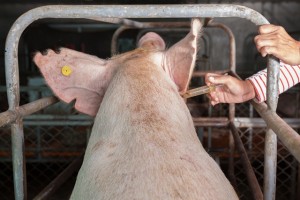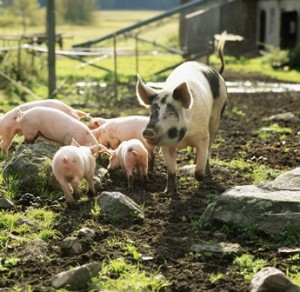Pig Diseases
Porcine Parvovirus
Porcine parvovirus (PPV) causes reproductive failure in pigs, characterised by embryonic and foetal death. Clinically, the disease in a herd manifests with decrease in litter size, return to service and increase in the number of mummified and/or stillborn piglets (van Leengoed et al., 1983; Mengeling, 1999).
Contaminated sites and premises are the main reservoir for the virus, which survives major temperature changes and is resistant to disinfectants. Whilst an infected pig only secretes the virus for a couple of weeks, the premises can remain infectious for up to four months (Mengeling and Paul 1986).
Pigs do not exhibit any clinical signs if infection is prior to the reproductive phase. Clinical outcome in sows or pregnant gilts depends on the time of the infection during gestation. The virus is widely spread throughout the world and is endemic in most pig herds in the UK (Mengeling, 1999; Nash, 1990; Robinson et al., 1985).
Control and Prevention of Porcine Parvovirus
Due to the ubiquitous nature of the disease, it is impossible to establish and/or maintain PPV-free herds, therefore gilts can be infected naturally or routinely vaccinated before breeding. However, the efficacy of the natural infection approach is not proven.
Natural Infection with Porcine Parvovirus
To encourage natural infection, gilts can be mixed with seropositive sows before breeding or at entry to a herd. Attempts to stimulate immunity in gilts by exposing them to contamination on the site may work, but needs to be monitored by serological testing, and this method rarely ensures 100% infection in gilts. Surveys carried out in indoor herds, where natural infection control was practiced, have found that the infection prevalence in gilts varies significantly (Einarsson et al., 1987; Pointon et al., 1983; Robinson et al., 1985; Too and Love, 1986).
Poor infection levels in gilts as a result of managed exposure to PPV often appear to explain the clinical patterns of the disease when an outbreak occurs, i.e., gilts/primiparous sows exhibit greatest losses in terms of reproductive failure (Huysman et al., 1992; Morrison and Joo, 1984; Pointon et al., 1983; Too and Love, 1986).
Vaccination Against Porcine Parvovirus

In herds that are prone to porcine parvovirus, vaccination is advocated. Since gilts are most susceptible, it is recommended that gilts selected for breeding should be vaccinated prior to service (Leengoed et al., 1983).
Vaccination is the only way to ensure active immunity in breeding gilts and sows (Edwards et al., 1986). Both inactivated and live vaccines have been developed, but only inactivated vaccines are available in the UK. Gilts should be vaccinated after passive immunity from colostrum has disappeared at about six months of age but before their first mating, in accordance with the Specific Product Characteristics of the vaccine used.
The use of routine vaccines in endemically infected herds has been advocated by many, particularly on a cost-benefit basis (Gardner et al., 1996; Nash, 1990; Parke and Burgess, 1993; Parsons et al., 1986). Others have found that revaccination of breeding animals after first gestation was not necessary (Einarsson et al., 1987). In one vaccination trial that took place between 1984 and 1986 and included 1243 gilts, from 12 herds in which approximately half of each herd was vaccinated, and half left un-vaccinated, there was little difference in reproductive performance between the groups. This is because incidence of PPV within different herds will vary. It is only when the same team looked closer at individual herds did the benefits of vaccination become apparent. From this it can be concluded that vaccination can be highly cost-effective for some farms, and not others (Wrathall, 1988).
Treating Porcine Parvovirus
There is no treatment for porcine parvovirus.
Porcine Parvovirus and Welfare
As there is very little that can be done to alleviate the symptoms once the infection has entered the herd, efforts should be concentrated on a robust vaccination policy and careful screening of all current and incoming stock, especially gilts. It is important to adhere to good biosecurity measures, including avoiding the use of stud boars that move from farm to farm, as this is a common way to spread parvovirus, as well as a range of other diseases from herd to herd.
Good Practice Based on Current Knowledge
- Monitor reproductive performance by good recording of service, farrowing and weaning
- Investigate any indication of failure in reproduction
- Investigate by laboratory examination any incidence of mummified foetuses
- If failure to farrow (despite anoestrus) is a major symptom, have the uteri of the culled “sows/gilts not in pig” examined
- Choose the preferred method of maintaining immunity: vaccination (vaccination of either all gilts and sows or only gilts) or natural infection (although this method may lack efficacy).
- Ensure adequate level of immunity in gilts entering the breeding herd either by purchasing vaccinated stock or by exposing gilts to infection before mating – see below on how to induce natural infection
Guidelines on How to Induce Natural Infection
Natural infection may not cover the whole herd, however it is an alternative to routine vaccinations. Care should be taken as the efficacy of this approach is not proven and it can lead to ongoing fluctuations in reproductive performance. Your veterinarian can provide further guidance:
- Buy in weaner gilts at an earlier age, at 30-35 kg liveweight
- Allow a minimum of five weeks for the integration and immunity building period in maiden gilts of over 5 months of age and monitor the transfer of immunity by serological testing
- Start the acclimatisation process at least seven weeks before mating
- Expose gilts to pathogens from the breeding herd by placing piglet dung and scours in the gilt paddock, repeating several times with fresh material
- Introduce cull sows to the gilt paddock (preferably small ones)
- Also, new boars should be subjected to a natural infection and acclimatisation process for a minimum of four weeks before mating


 American English
American English


Comments are closed.